The ASRock X299E-ITX/ac Motherboard Review: An 18-core No-Compromise Mini-ITX
by Joe Shields on December 4, 2017 8:00 AM ESTVisual Inspection
The socket, the four SO-DIMM slots, and the PCIe slot dominate the face of the black, 10 layer board. Sticking up from the board are the two daughter boards for M.2 as well as the SATA and USB connections. The brushed aluminium chipset heatsink with the ASRock name sits below the back panel IO next to a reset CMOS switch.
The board is busy, and it has to be with the connectivity it brings to the tabl,e and its size. Mini-ITX boards are a tough component to be pleasing to the eye - due to the small size it becomes more difficult to add aesthetic touches and it is more worthwhile to have more functionality instead. To that end, the ASRock X299E-ITX/ac goes without any shrouding over the back panel IO and also does not have any RGB LEDs. There is a single RGB LED header located on the top right-hand corner above the 8-pin EPS 12V connector.
Starting off with fan headers we will find a total of three on the board, which is usual for high-end mini-ITX boards. The first, a 4-pin chassis/pump fan, is located in the upper left-hand corner above the Wi-Fi module and to the left of the VROC header. The other two 4-pin headers, for a CPU and CPU water pump, are located just above the 24-pin ATX 12V connector on the right side. These two are able to auto sense DC or PWM and adjust the control method depending on which type of fan is on the header. The CPU fan connector supports up to 1A/12W and the CPU OPT/W PUMP header is able to output 1.5A(18W).
Audio duties are handled by the latest 7.1 CH Realtek ALC1220 codec supporting Purity Sound 4 and DTS connect. EMI protection and board separation are not found on the board, however it does use Nichicon premium audio caps.
We took off the daughterboards and heatsinks to expose the 7-phase VRM. The X299E-ITX/ac uses 60A Intersil DRMos MOSFETs, premium 60A Power Chokes, and an Intersil ISL69138 7-phase PWM controller (one for the CPU, the other for memory). The 12K caps found on the Taichi and Gaming i9 are also used in this setup. The heatsink is small covered, and was warm while running. I wouldn't recommend overclocking heavily without good airflow, or I would suggest spot cooling if really pushing things.
Looking at a top-down view of the right side, we can see the 24-pin ATX connector on the left, then on the riser card is a USB 3.0 header, six SATA ports, and a USB 2.0 header. To the right of it is the 8-pin EPS 12V plug, front panel header and RGB LED header.
The primary M.2 slot is provided by a riser card plugged into a fifth 'SO-DIMM-like' slot, similar to how ASUS uses a DDR4 slot for its M.2 riser card. The riser card has a single M.2 slot which supports both SATA and PCIe 3.0 modules up to 80mm in length. The other two slots are located on the back of the motherboard supporting only 80mm length and PCIe 3.0 x4 only modules.
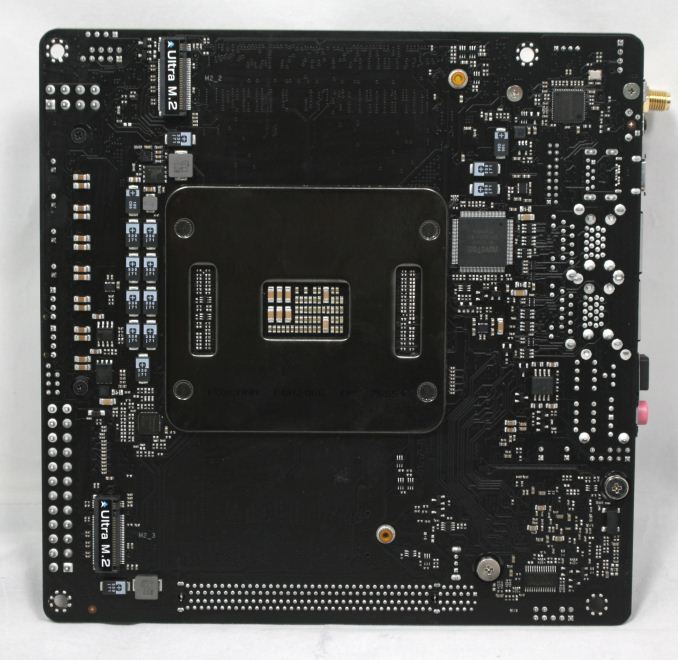
Spot the dual M.2 slots that say 'Ultra M.2'
The back M.2 slots are where VROC is supported.
The next image is the riser card holding the SATA ports as well as the USB 3.0 header and USB 2.0 header. This unit is mounted to the VRM heatsink via screws and plugs into the motherboard just below and to the right of the socket.
The back panel IO shows the Intel Wi-Fi module, a CMOS reset button, the USB 3.1 (10 Gbps) ports in lighter blue, four USB 3.0 ports and the two Intel NICs along with the gold-plated 5 plug audio stack with SPDIF. Not a lot of USB back here, but it is to be expected on such a small board. Normally on a board this size we might see a 3-port audio solution to save space, but ASRock has given it the full stack.
In The Box
We get the following:
- Quick Installation Guide, Support CD, I/O Shield
- 4 x SATA Data Cables
- 1 x ASRock WiFi 2.4/5 GHz Antenna
- 3 x Screws for Ultra M.2 Sockets
The included accessories are fairly sparse, however, it is enough to get running out of the box. Instructions, drivers, SATA cables, the I/O Plate, and Antenna are included.


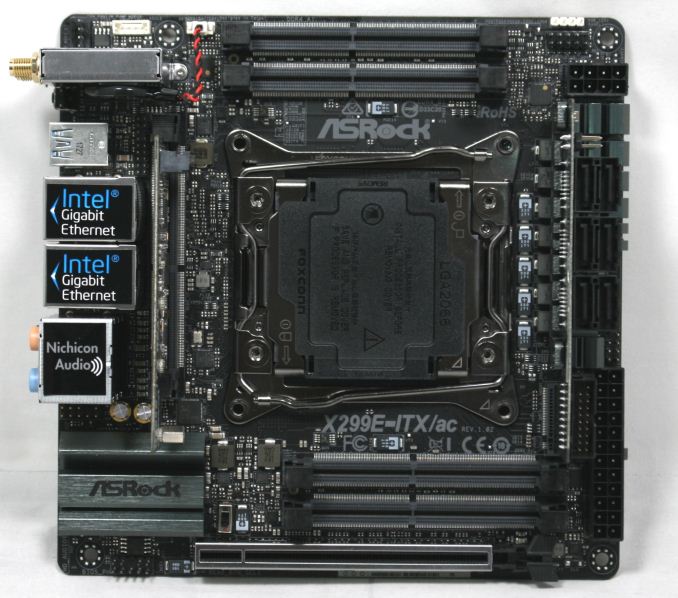
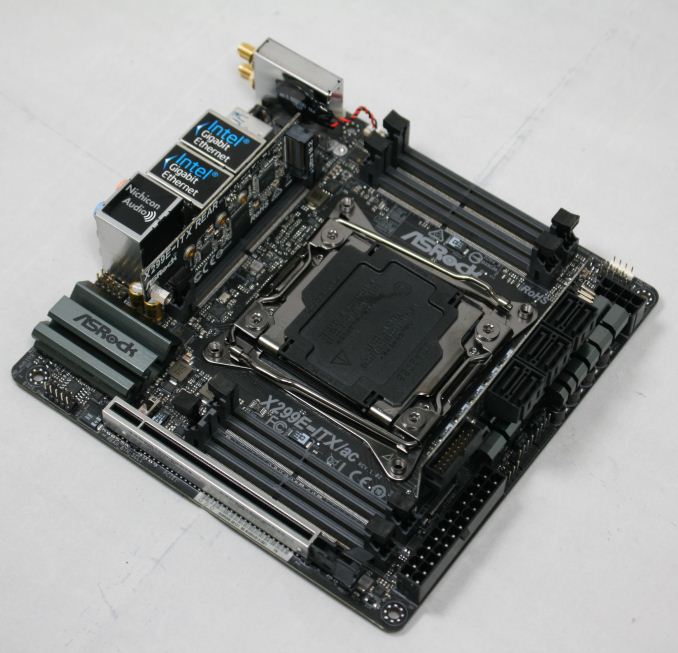
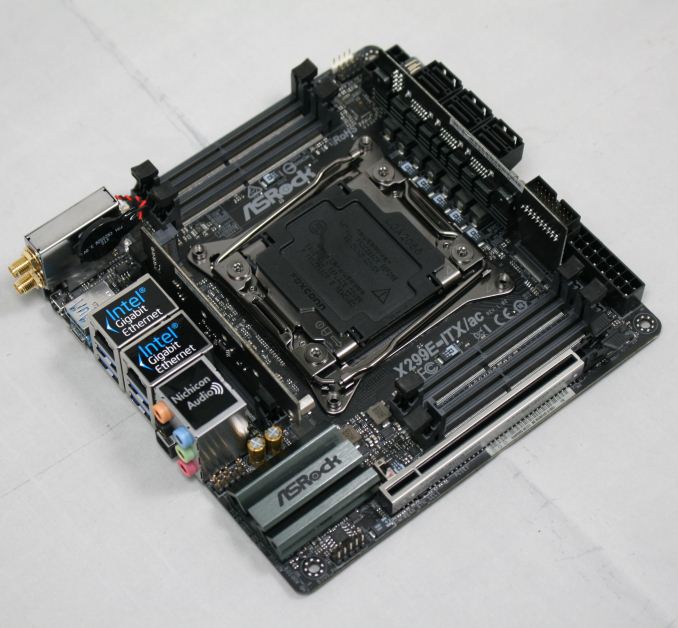


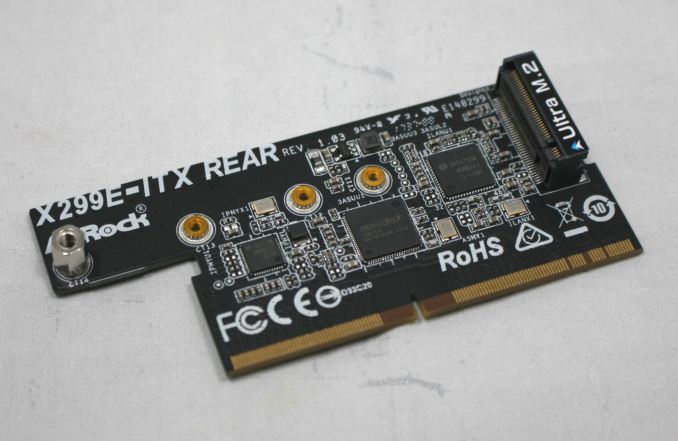
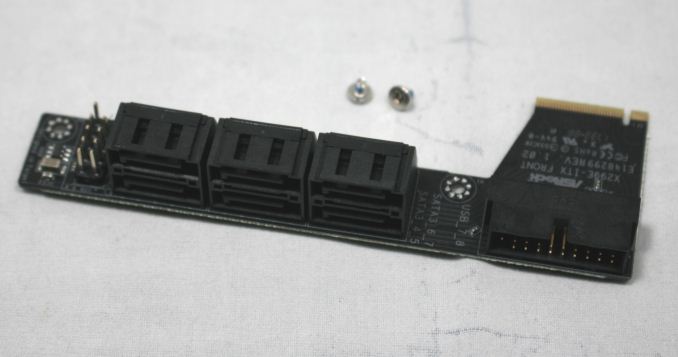
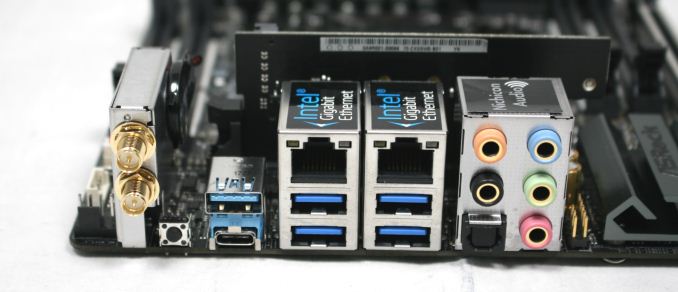















24 Comments
View All Comments
dgingeri - Monday, December 4, 2017 - link
Of course there are compromises. The processor has 44 PCIe lanes, and only 16 are able to be used thanks to there only being one slot. Even with the riser card and the M.2 slots, there are still compromises with this.Samus - Monday, December 4, 2017 - link
I've had the ASRock X99 ITX for two years. The sole compromise is literally one PCIe x16 slot, which is all 95% of people in the market for this board need. If you need more, you go ATX. Nobody is building ITX systems with SLI or mining in mind. Nobody. With the exception of maybe one SFX PSU, they can't even drive more than one high end videocard with a platform like this, and if you are using a case that holds an ATX PSU, why are you even considering an ITX board? The whole point of the system is to be compact.In other worse, this X299 follow-up is simply amazing. 9 native storage device ports on an ITX board is unheard of. Many ITX boards still have just 4 SATA ports (which, again, is all most people in the market for an ITX system are looking for since most cases will lack more than 4 storage bays.)
Gadgety - Monday, December 4, 2017 - link
"If you need more, you go ATX."Well, yes and no. I know there are users who have used the x99 with bifurcation, in those 5%. I'd like a small pc in with a top of the line gpu and need a pci-e x1 for an additional feature. The trend for small PCs certainly seems to be growing, so offering additional pci-e possiblities on small M-ITX would be nice, whether through official bifurcation possibilities or other means. I checked the potential to using an M.2 port for a pci-e card, but couldn't find an adapter.
Vatharian - Monday, December 4, 2017 - link
I am so sad that DTX didn't took off. Just a tiny little bit of real estate, most of cases already have two slots for wide GPUs, and so much more options. If this board been DTX with 2x 16x ports, Titan Xp SLI would have been possible out of the box (albeit with water cooling, of course). Or stuff powerful storage controller in one and decent 10G or 40G network card in the other port. Or stuff really anything int he other slot.Gigaplex - Monday, December 4, 2017 - link
There's always micro ATX. It's not that different to DTX.Actae0n - Monday, December 4, 2017 - link
You certainly raise a good point. However, there are some cases, such as the Fractal Design Nano S (pretty sweet case, I might add), that only support Mini-ITX and can hold an ATX PSU.dgingeri - Monday, December 4, 2017 - link
It was not my point that it didn't have a use, but rather that the article is titled "The ASRock X299E-ITX/ac Motherboard Review: An 18-core No-Compromise Mini-ITX" when in fact there is a compromise in order to get to the form factor. I don't like people stating "no compromise" when in fact there is compromise in something.tim851 - Monday, December 4, 2017 - link
The single PCI-E x16 slot is not a compromise, it's A FEATURE. That's what you buy an ITX board for.Mr Perfect - Monday, December 4, 2017 - link
Yeah, calling out ITX for only having one PCIe slot is kind of missing the point of ITX.mnoi - Wednesday, December 6, 2017 - link
I agree, the two usb-c ports should have been thunderbolt enabled at the very least.